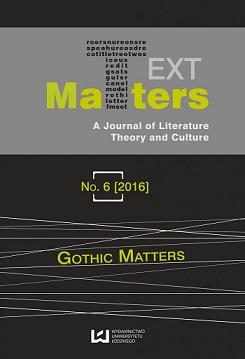The Tell-Tale Hand: Gothic Narratives and the Brain
DOI:
https://doi.org/10.1515/texmat-2016-0006Abstract
The opening story in Winesburg, Ohio (1919) by Sherwood Anderson is called simply “Hands.” It is about a teacher’s remarkable hands that sometimes seem to move independently of his will. This essay explores some of the relevant contexts and potential links, beginning with other representations of teachers’ hands, such as Caravaggio’s St. Matthew and the Angel, early efforts to establish a sign-language for the deaf, and including the Montessori method of teaching children to read and write by tracing the shape of letters with their hands on rough emery paper. The essay then explores filmic hands that betray or work independently of conscious intentions, from Dr Strangelove, Mad Love, to The Beast With Five Fingers. Discussion of the medical literature about the “double” of our hands in the brain, including “phantom hands,” leads on to a series of images that register Rodin’s lifelong fascination with sculpting separate hands.
Downloads
References
Anderson, Sherwood, Winesburg, Ohio. New York: Huebsch, 1919. Bartleby.com. Web. 14 Aug. 2015.
Google Scholar
Bolens, Guillemette. The Style of Gestures: Embodiment and Cognition in Literary Narrative. Baltimore: Johns Hopkins UP, 2012. Print.
Google Scholar
Campbell, Gordon. The Oxford Dictionary of the Renaissance. Oxford: Oxford UP, 2003. Print.
Google Scholar
Cartmill, Erica A., Sian Beilock, and Susan Goldin-Meadow. “A Word in the Hand: Action, Gesture and Mental Representation in Humans and Non-Human Primates.” Philosophical Transactions of the Royal Society B: Biological Sciences 367.1585 (2011): 129-43. Ncbi.nlm.nih.gov. 21 Nov. 2011. Web. 23 Feb. 2014.
Google Scholar
Damasio, Antonio. Looking For Spinoza: Joy, Sorrow and the Feeling Brain. London: Vintage, 2004. Print.
Google Scholar
Evers, Stuart. “Sherwood Anderson.” Morphologies. Ed. Ra Page. Manchester: Comma, 2014. Print.
Google Scholar
Forsyth, Neil. “Hands On.” A Concise Companion to the Study of Manuscripts, Printed Books, and the Production of Early Modern Texts. Ed. Edward Jones. Oxford: Wiley, 2015. 294–321. Print.
Google Scholar
Gibbs, Raymond. Embodiment and Cognitive Science. Cambridge UP, 2006. Print
Google Scholar
Goldberg, Jonathan. Writing Matter: From the Hands of the English Renaissance. Stanford: Stanford UP, 1990. Print
Google Scholar
Marraud, Hélène. Rodin. La main révèle l’homme. Paris: Collection Tout L’oeuvre, éditions du musée Rodin. 2005. Print.
Google Scholar
Ramachandran, V. S. The Tell-Tale Brain. New York: Norton, 2012. Print.
Google Scholar
Rilke, Rainer Maria. Auguste Rodin. Trans. Daniel Slager. New York: Archipelago, 2004. Print.
Google Scholar
Ruiz-Gómez, Natasha. “Essence and Evanescence in the Hands of Rodin.” Ephemera: Thresholds 31. Boston: MIT, 2006. 103–06. Print.
Google Scholar
Ruiz-Gómez, Natasha. Rev. of Rodin. La main révèle l’homme, by Hélène Marraud. Nineteenth-Century Art Worldwide 5.2 (2006): n. pag. Web. 7 June 2014
Google Scholar
Sacks, Oliver. Hallucinations. New York: Knopf, 2012. Print.
Google Scholar
Sawday, Jonathan. The Body Emblazoned: Dissection and the Human Body in Renaissance Culture. London: Routledge, 1995. Print.
Google Scholar
Sherman, William H. Used Books: Marking Readers in Renaissance England. Philadelphia: U of Pennsylvania P, 2008. Print.
Google Scholar
Verdan, Claude. La Main: Cet Univers. Lausanne: Editions du Verseau, 1994. Print.
Google Scholar
Vessel, Edward A. G., Gabrielle Starr, and Nava Rubin. “Art Reaches Within: Aesthetic Experience, the Self, and the Default Mode.” Frontiers in Neuroscience. 30 Dec. 2013. Web. 12 Feb. 2014.
Google Scholar
Wittgenstein, Ludwig. Philosophical Investigations [1953]. Oxford: Blackwell, 2001. Print.
Google Scholar
Downloads
Published
How to Cite
Issue
Section
License

This work is licensed under a Creative Commons Attribution-NonCommercial-NoDerivatives 4.0 International License.













